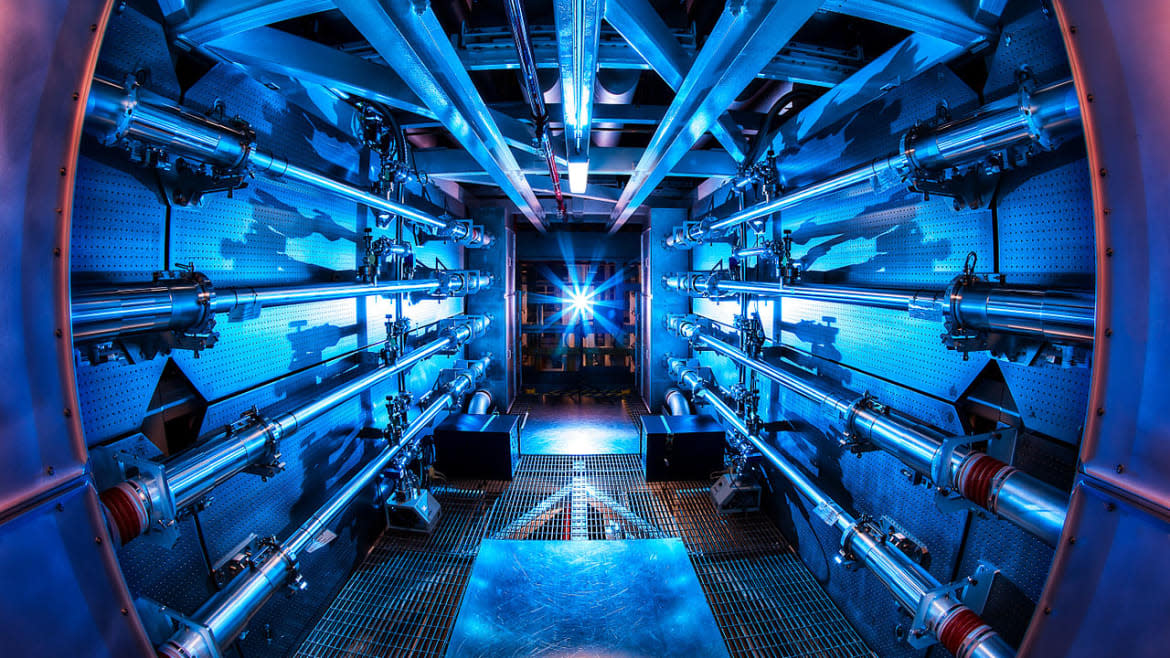Why the U.S. Fusion Energy Discovery Really Is ‘Revolutionary’

There’s an old joke among scientists: Fusion power is just 50 years away—and always will be. However, that timeline might get just a bit smaller soon enough.
The U.S. Department of Energy is set to announce Tuesday that its scientists at the National Ignition Facility at Lawrence Livermore National Laboratory in California have achieved a ”breakthrough” in fusion energy—marking a massive milestone on the road to creating clean, sustainable power. Though the significance of this depends on who you speak with.
First, a quick and dirty physics lesson: Fusion energy is a method of producing electricity by smashing (or fusing) atoms together, releasing enormous gobs of energy in the process. This reaction occurs constantly on stars like the sun, which fuses 500 tons of hydrogen atoms every second. If we could replicate this reaction on Earth, we could have a source of virtually unlimited clean energy.

The target chamber at the National Ignition Facility where nearly 200 laser beams are focused on on a gold capsule containing deuterium and tritium.
But that’s easier said than done. For decades, fusion scientists have attempted to create reactions by essentially shooting high-powered laser beams at hydrogen atoms. However, they’ve struggled to reach a phenomenon called “ignition,” which is a break-even point when a fusion reactor produces more energy than it consumes.
Researchers have gotten close in the past—the NIF was able to produce 70 percent of the energy needed to begin a fusion reaction in 2021. The lab might now be a massive step closer after new experiments reportedly resulted in a net energy gain, which means it extracted more energy from the fusion reaction than was required to trigger it, according to The Financial Times.
But wait, isn’t that the same thing as ignition? Not quite. Ignition requires the nuclear reaction to be self-sustaining, which means that it creates a chain of reactions that create other reactions and so on. When that happens, things start to really cook (just make sure the robot octopus arms you’re using for the experiment don’t get damaged in the process).
“You don’t have to keep on throwing matches into a fire to keep it burning,” Arturo Dominguez, a plasma physicist at Princeton Plasma Physics Laboratory who wasn’t involved in the experiment, told The Daily Beast. “The heat from the fire itself is going to keep it going as long as you have enough fuel. That’s ignition.”
FT reported that the latest experiment used 2.1 megajoules of energy to produce 2.5 megajoules—or 120 percent more than what was needed to create it. However, the data is currently being verified. “Our analysis is still ongoing, so we’re unable to provide details or confirmation this time,” a spokesperson for LLNL told The Daily Beast.
If the alleged breakthrough turns out to be true, then it would mark the first time researchers have been able to create more energy than they put in fusion reactions. “We’ve never gotten that energy gain. We’ve never gotten more energy out than the energy you put in,” Dominguez explained. “So this would be revolutionary.”
The Door to Fusion Energy Might Have Just Been Unlocked
But we’re still a long, long way from being able to incorporate fusion into our energy infrastructure. For one, the NIF’s experiment utilized a program called inertial confinement fusion, which involves zapping a small amount of hydrogen plasma with nearly 200 of the world’s biggest lasers. This creates a series of quick explosions, heating up the reactor to 150 million degrees Celsius, or roughly 10 times hotter than the center of the sun.
While very sci-fi, the energy production occurs in the span of nanoseconds—not quite the self-sustaining reaction we’d get from ignition. The energy it created was tiny too. In fact, one scientist told CNN that the recent NIF reaction created just enough energy to “boil 10 kettles of water.” That’s not enough to power a house, let alone entire nations.
So, despite the immense hype surrounding the fusion announcement, this doesn’t mean we’re anywhere close to actually achieving the “holy grail” of clean energy—and, in fact, are still very far away from making fusion a reality.
However, this doesn’t mean that this isn’t a cause for celebration—especially for all of the scientists and researchers who have been working at net energy gain for so long. Their efforts have only become more popular as nations begin to recognize the game changing potential of fusion energy. As a result, countries such as the U.S. and China have been pouring billions into researching the technology in recent years.
Now, they finally have something to show for it.
“This [experiment] doesn’t mean that electricity from fusion is around the corner,” Dominguez said. “But what this does mean is that there is a physics basis for the work that’s being done in fusion. And we’ve proven now in an experiment that you can get more energy out than energy that goes in.”
Got a tip? Send it to The Daily Beast here
Get the Daily Beast's biggest scoops and scandals delivered right to your inbox. Sign up now.
Stay informed and gain unlimited access to the Daily Beast's unmatched reporting. Subscribe now.

